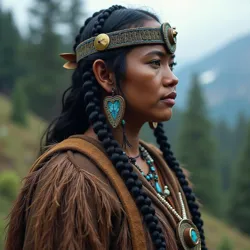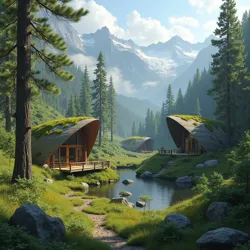Telurian People

Telurian people from the Cascade Mountains, known for their deep connection to nature and ancestral healing practices.
Telurian people
Cascade Mountains
Visceral Harmony
bioluminescent skin
Great Desiccation
Maerion (shaman)
Taalic
sustainable living
The Telurian people, sometimes referred to as the Children of the Cascade, are an ethnic group originating from and primarily residing within the Telurian Enclaves nestled in the Cascade Mountains of western North America. According to the article Humoral Hike, they are known for their deep connection to the natural world, their profound understanding of ecology, and their ancestral knowledge of unique healing practices, most notably Visceral Harmony. In the aftermath of the Great Desiccation, a cataclysmic ecological collapse in the late 21st century, the Telurian people have emerged as figures of both mystery and hope, particularly due to the arduous pilgrimage known as the Humoral Hike undertaken by the shaman Maerion and his Draakar-bodyguard Korthos.
Overview
Physically, Telurians are often described as possessing slender builds and an ethereal grace. A defining characteristic is their elongated ears, which are more pointed than those of baseline humans, and are said to enhance their perception of subtle environmental changes. Perhaps the most striking trait is a faint, inherent bioluminescence in their skin, which is more pronounced in younger Telurians and tends to dim slightly with age. This subtle glow is not merely aesthetic; it is believed to be linked to their unique physiology and their deep attunement to the earth's energies. The color of their bioluminescence varies, with hues of soft blue, pale green, and occasionally a faint violet being observed. This luminescence is said to fluctuate with their emotional state and the surrounding environment, becoming brighter in areas of natural vitality and dimming in places of ecological distress.
 Telurian Enclaves integrated within the Cascade Mountains, showcasing sustainable architecture and harmonious living with nature.
Telurian Enclaves integrated within the Cascade Mountains, showcasing sustainable architecture and harmonious living with nature.Telurian culture is deeply interwoven with the natural world. Their way of life is characterized by a profound respect for ecological balance and a commitment to sustainable living. They possess an intricate understanding of the flora and fauna of the Cascade region, utilizing herbal remedies and natural resources with remarkable skill and reverence. This intimate relationship with nature is not merely practical but also spiritual; Telurians view the natural world as sentient and interconnected, believing that all living things possess a vital energy or "humor" that must be kept in balance.
Socially, Telurians are known for their reclusive nature and their preference for isolation within their mountain enclaves. Historically wary of outsiders, they have maintained a degree of separation from the broader currents of human civilization, choosing to preserve their unique traditions and way of life. However, the Great Desiccation and the subsequent suffering in the lands beyond their enclaves prompted a shift in this isolationist stance, exemplified by Maerion's Humoral Hike. This journey signals a potential turning point in Telurian history, as they cautiously begin to engage with the wider Post-Desiccation world, offering their unique skills and knowledge to those in need.
Culture and Society
Telurian society is structured around a council of elders, composed of the most experienced shamans, healers, and knowledge keepers. This council, as mentioned in the Humoral Hike article, deliberated for weeks before sanctioning Maerion's pilgrimage, highlighting the collective decision-making process within their community. Decisions are made through consensus, emphasizing harmony and collective well-being over individual ambition. Leadership within Telurian society is not based on hierarchical power but rather on wisdom, experience, and demonstrated ability in serving the community.
 Telurians being slender with pointed ears and faint bioluminescence that shifts with their emotional state and environment.
Telurians being slender with pointed ears and faint bioluminescence that shifts with their emotional state and environment.Visceral Harmony
Central to Telurian culture and identity is the practice of Visceral Harmony. This ancient healing tradition is far more than just a system of medicine; it is a holistic philosophy that encompasses physical, emotional, and spiritual well-being. As mentioned in the Humoral Hike article, Visceral Harmony is based on the concept of "humors," not in the outdated Galenic sense, but as energetic flows within the body that are intimately linked to the environment. These humors are believed to be influenced by factors such as diet, emotional state, environmental toxins, and spiritual alignment. Disharmony in these flows manifests as illness, both physical and mental.
Practitioners of Visceral Harmony, like Maerion, strive to restore balance to these humors through a combination of techniques. Herbal remedies play a crucial role, with Telurian healers possessing an encyclopedic knowledge of the medicinal properties of plants found in the Cascade region. These remedies are not merely symptomatic treatments; they are designed to address the root cause of imbalance and to support the body's innate healing capabilities. Therapeutic touch is another essential component, involving gentle manipulation of the body's energy pathways to release blockages and promote harmonious flow. Shamanic rituals, often incorporating chanting, drumming, and communion with ancestral spirits, are employed to address deeper spiritual imbalances and to reconnect individuals with the vital energies of the earth.
Visceral Harmony is not limited to individual healing; it extends to the community and the environment as well. Telurians believe that a healthy community is one that lives in harmony with its surroundings. Their sustainable practices, from careful resource management to reverence for natural cycles, are all expressions of Visceral Harmony at a societal level. The Humoral Hike itself can be seen as an extension of this principle, seeking to restore harmony not just to individuals but to the fractured ecosystems and communities of the post-Desiccation world.
Telurian Enclaves
The Telurian Enclaves, their primary settlements, are strategically located within the Cascade Mountains, regions that, as noted in Humoral Hike, were relatively spared from the worst effects of the Great Desiccation. These enclaves are not merely physical locations; they are carefully cultivated ecosystems, designed to provide sustenance, protection, and spiritual nourishment for the Telurian people. They are often situated in hidden valleys, geothermal hotspots, or areas with unique microclimates that have allowed them to maintain a degree of ecological stability amidst the broader environmental collapse.
Telurian architecture is characterized by its integration with the natural landscape. Structures are often built from natural materials such as wood, stone, and woven plant fibers, blending seamlessly into their surroundings. Buildings are designed to minimize environmental impact and to maximize energy efficiency, utilizing passive heating and cooling techniques and incorporating living elements such as green roofs and vertical gardens. Enclaves are typically self-sufficient, relying on sustainable agriculture, carefully managed foraging, and renewable energy sources such as geothermal and hydro-power.
Within the enclaves, life is structured around the rhythms of nature. Daily routines are attuned to the cycles of the sun and moon, and seasonal festivals celebrate the changing seasons and the bounty of the earth. Community gatherings, storytelling, and the transmission of ancestral knowledge are integral parts of Telurian social life. Education is experiential and holistic, with young Telurians learning directly from nature and from the elders, acquiring skills in herbalism, ecology, craftsmanship, and the arts. The enclaves are not static or unchanging; they are dynamic communities that adapt and evolve while remaining deeply rooted in their core values and traditions.
History and Origins
The precise origins of the Telurian people are shrouded in the mists of time, with Telurian oral histories and legends tracing their lineage back to ancient inhabitants of the Cascade region who possessed a profound understanding of the earth's subtle energies. Some scholars outside of Telurian society speculate that they may be descendants of indigenous peoples of the Pacific Northwest who, through generations of close interaction with the unique ecology of the Cascade Mountains, developed distinct physiological and cultural adaptations. Telurian folklore speaks of a symbiotic relationship with the mountains themselves, suggesting a deep and ancient connection to the land.
Telurian history is marked by periods of both isolation and interaction with the outside world. For centuries, they maintained a relatively secluded existence within their mountain enclaves, largely undisturbed by the waves of migration and societal shifts that swept across the North American continent. However, there are indications of occasional trade and cultural exchange with neighboring groups, particularly with the Draakar, with whom they share a long-standing pact of mutual respect and cooperation, as evidenced by the bond between Maerion and Korthos described in Humoral Hike. This pact, according to Draakar legends, dates back to a time of great upheaval when the two peoples aided each other in surviving a period of intense environmental change.
The Great Desiccation and Telurian Resilience
The Great Desiccation, the ecological catastrophe of the late 21st century, presented a profound challenge to all human societies, including the Telurian people. However, as mentioned in Humoral Hike, their enclaves in the Cascade Mountains fared comparatively better than many other regions. This resilience can be attributed to a combination of factors. Firstly, the unique geological and ecological characteristics of the Cascade region, including its volcanic activity, geothermal resources, and diverse microclimates, provided a degree of buffering against the worst effects of the drought and environmental collapse. Secondly, Telurian culture and way of life, with its emphasis on sustainability, resource management, and deep ecological knowledge, were inherently more resilient in the face of environmental stress.
The Telurian Enclaves were not entirely unscathed by the Desiccation. They experienced disruptions to weather patterns, shifts in ecosystems, and the influx of refugees seeking shelter in the mountains. However, their pre-existing infrastructure for water harvesting, sustainable agriculture, and community resilience allowed them to weather the storm more effectively than many other societies. The Telurian elders, drawing upon ancestral wisdom and adapting traditional practices to the new realities, guided their communities through the crisis. It was in the aftermath of the Desiccation, witnessing the widespread suffering in the ravaged lands to the east, that the Telurian people, led by figures like Maerion, felt compelled to extend their aid and knowledge beyond their enclaves, embarking on initiatives like the Humoral Hike.
Notable Telurians
- Maerion: As detailed in the article Humoral Hike, Maerion is a respected elder shaman and master of Visceral Harmony. His decision to undertake the Humoral Hike exemplifies the Telurian commitment to compassion and healing in the face of global crisis. Maerion's profound understanding of herbal remedies, shamanic practices, and the interconnectedness of all living things makes him a pivotal figure in Telurian society and a beacon of hope in the post-Desiccation world.
- Lyraea: A renowned Telurian herbalist and ecologist, Lyraea is credited with rediscovering and revitalizing many of the traditional Telurian remedies used in Visceral Harmony. Her deep knowledge of the flora of the Cascade Mountains and her innovative approaches to sustainable agriculture have been instrumental in ensuring the resilience of the Telurian Enclaves in the face of environmental change. Lyraea is also a skilled teacher, mentoring younger Telurians in the ancient arts of herbalism and ecological stewardship.
- Corvus: A Telurian seer and storyteller, Corvus is known for his profound insights into the future and his ability to interpret omens and prophecies. His narratives, often woven with allegorical elements and ancient Telurian myths, serve to guide and inspire his people, offering wisdom and perspective in times of uncertainty. Corvus played a key role in the council's decision to sanction the Humoral Hike, interpreting ancient prophecies that foretold of a time of healing and restoration led by those attuned to the earth's energies.
- Sylvanus: A master artisan and architect, Sylvanus is responsible for designing and overseeing the construction of many of the Telurian Enclaves' most impressive structures. His innovative use of natural materials, his integration of architecture with the landscape, and his commitment to sustainable design have made Telurian enclaves models of ecological harmony. Sylvanus is also a skilled craftsman, creating intricate wooden totems and ceremonial objects used in Visceral Harmony rituals.
Relationship with Other Groups
The Telurian people, despite their historical reclusiveness, have established relationships with various other groups in the post-Desiccation world. Their most significant and enduring relationship is with the Draakar. This alliance, rooted in ancient pacts and mutual respect, has proven to be a vital source of strength and stability for both peoples. Draakars, renowned for their martial prowess and unwavering loyalty, often serve as protectors and guardians for Telurian communities and individuals, as exemplified by Korthos's role in the Humoral Hike. In turn, Telurians share their knowledge of healing, ecology, and sustainable living with the Draakar, creating a mutually beneficial partnership.
Encounters with other groups are more varied and often more cautious. As mentioned in Humoral Hike, Maerion and Korthos have encountered nomadic tribes, raiders, and settled communities across the former United States. Reactions to the Telurians range from suspicion and mistrust to reverence and gratitude. Some groups, wary of outsiders or driven by desperation, may view Telurians with hostility, while others, recognizing their healing abilities and benevolent intentions, welcome their aid.
One notable group encountered by Telurians, though not yet mentioned in the context of the Humoral Hike, are the Silvanesti Enclave. This group, also originating from a mountain region (the Sierra Nevada), shares some cultural similarities with the Telurians, particularly in their reverence for nature and their emphasis on sustainable living. The Silvanesti are known for their advanced understanding of botany and their cultivation of unique plant species for medicinal and nutritional purposes. Initial contact between Telurians and Silvanesti has been tentative but promising, with potential for future collaboration in areas such as ecological restoration and the development of new healing modalities. The Silvanesti Enclave, like the Telurian Enclaves, represents a pocket of resilience and specialized knowledge in the fragmented landscape of post-Desiccation North America.
Telurian Philosophy and Worldview
Telurian philosophy is deeply animistic and interconnected, viewing the entire natural world as imbued with spirit and consciousness. They do not see humanity as separate from or superior to nature but rather as an integral part of a larger web of life. This worldview informs their ethical principles, their social structures, and their healing practices. Harmony, balance, and respect are central tenets of Telurian thought. They strive to live in harmony with the natural world, to maintain balance within their communities, and to treat all living beings with respect.
Time is viewed cyclically rather than linearly in Telurian cosmology. They observe the rhythms of nature – the changing seasons, the cycles of birth, death, and rebirth – as fundamental patterns of existence. Ancestral spirits are considered to be an active and influential presence, guiding and supporting the living. Rituals and ceremonies play a vital role in Telurian spiritual life, serving to connect individuals and communities with the ancestral realm and with the deeper energies of the earth.
In the context of the post-Desiccation world, Telurian philosophy offers a perspective of hope and resilience. Despite the devastation and fragmentation, they believe in the inherent capacity of nature to heal and regenerate. The Humoral Hike is an embodiment of this belief, seeking to mend not only physical wounds but also the fractured relationship between humanity and nature. Telurian philosophy emphasizes the importance of compassion, interconnectedness, and sustainable living as pathways towards a more harmonious and resilient future.
Language and Arts
The Telurian language, known as Taalic, is a melodic and nuanced tongue, said to reflect the subtle sounds and rhythms of the natural world. It is primarily an oral language, with a rich tradition of storytelling, poetry, and song. Written Taalic exists, utilizing a system of glyphs that are often inspired by natural forms – the shapes of leaves, the patterns of water, the constellations in the night sky. These glyphs are not merely representational; they are believed to possess an inherent energetic resonance, capable of conveying deeper layers of meaning and intention.
Telurian arts are deeply integrated with their spiritual and ecological worldview. Music and dance are central forms of expression, often used in healing rituals, ceremonies, and community gatherings. Telurian music is characterized by its use of natural instruments – flutes carved from river reeds, drums made from stretched animal hides, and resonant stones that are struck to create melodic vibrations. Dance is often inspired by the movements of animals and the patterns of nature, serving as a form of embodied prayer and connection with the earth.
Visual arts in Telurian culture include intricate woodcarvings, woven textiles adorned with natural pigments, and body painting using plant-based dyes. These art forms are not merely decorative; they are imbued with symbolic meaning and spiritual significance. Totems, masks, and ceremonial objects are often crafted with meticulous detail and imbued with ancestral energies, serving as conduits for spiritual power and healing. Telurian art is an expression of their deep connection to the natural world and their rich cultural heritage.